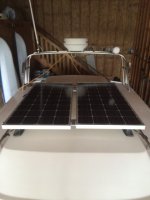I just received a set of Renogy 100w solar panels — 1 rigid frame, 1 flexible (order mistake. — one will go back).
But now that I have the flexible panel I am considering keeping it and mounting it on the roof with industrial strength Velcro. That way I can remove it for transport or whenever it’s not required.
But the flex panels are shorter lived and apparently not as effective.
Thoughts?
But now that I have the flexible panel I am considering keeping it and mounting it on the roof with industrial strength Velcro. That way I can remove it for transport or whenever it’s not required.
But the flex panels are shorter lived and apparently not as effective.
Thoughts?

